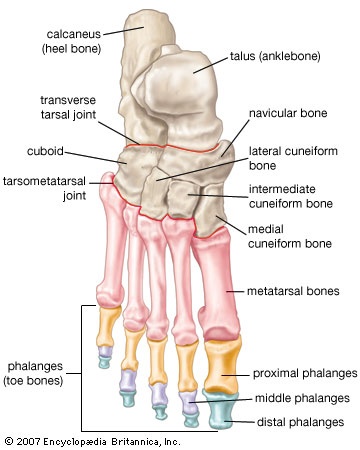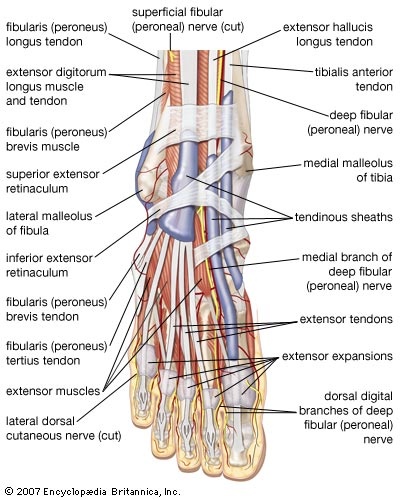foot
measurement
plural feet
in measurement, any of numerous ancient, medieval, and modern linear measures (commonly 25 to 34 cm) based on the length of the human foot and used exclusively in English-speaking countries, where it generally consists of 12 inches or one-third yard. In most countries and in all scientific applications, the foot, with its multiples and subdivisions, has been superseded by the metre, the basic linear unit in the metric system. In the United States the definition of the foot as exactly 30.48 cm took effect in 1959.
prosody
plural Feet,
in verse, the smallest metrical unit of measurement. The prevailing kind and number of feet, revealed by scansion, determines the metre of a poem. In classical (or quantitative) verse, a foot, or metron, is a combination of two or more long and short syllables. A short syllable is known as an arsis, a long syllable as a thesis. There are 28 different feet in classical verse, ranging from the pyrrhic (two short syllables) to the dispondee (four long syllables). The adaptation of classical metrics to the strongly accented Germanic languages, such as English, does not provide an entirely reliable standard of measurement. The terminology persists, however, a foot usually being defined as a group of one stressed (́) and one or two unstressed (˘) syllables. An exception is the spondee, which consists of two stressed syllables; in English verse, this is usually two monosyllables, such as the phrase “He who.” The commonest feet in English verse are the iamb, an unstressed followed by a stressed syllable, as in the word ˘re| ́port; the trochee, a stressed followed by an unstressed syllable, as in the word ́dai|˘ly; the anapest, two unstressed syllables followed by a stressed syllable, as in ˘ser|e˘| ́nade; and the dactyl, a stressed syllable followed by two unstressed syllables, as in ́mer|˘ri|˘ly.
If a single line of the poem contains only one foot, it is called monometer; two feet, dimeter; three feet, trimeter; four feet, tetrameter; five feet, pentameter; six feet, hexameter; seven feet, heptameter; eight feet, octameter. More than six, however, is rare. The metre of a poem (e.g., iambic pentameter, dactylic hexameter) is the kind plus the number of feet in each line.
vertebrate anatomy
plural feet

 in anatomy, terminal part of the leg of a land vertebrate, on which the creature stands. In most two-footed and many four-footed animals, the foot consists of all structures below the ankle joint: heel, arch, digits (digit), and contained bones such as tarsals (tarsal), metatarsals (metatarsal), and phalanges; in mammals that walk on their toes and in hoofed mammals, it includes the terminal parts of one or more digits.
in anatomy, terminal part of the leg of a land vertebrate, on which the creature stands. In most two-footed and many four-footed animals, the foot consists of all structures below the ankle joint: heel, arch, digits (digit), and contained bones such as tarsals (tarsal), metatarsals (metatarsal), and phalanges; in mammals that walk on their toes and in hoofed mammals, it includes the terminal parts of one or more digits.The major function of the foot in land vertebrates is locomotion. Three types of foot posture exist in mammals: (1) plantigrade, in which the surface of the whole foot touches the ground during locomotion (e.g., human, baboon, bear), (2) digitigrade, in which only the phalanges (toes, fingers) touch the ground, while the ankle and wrist are elevated (e.g., dog, cat), and (3) unguligrade, in which only a hoof (the tip of one or two digits) touches the ground—a specialization of running animals (e.g., horse, deer).
In primates the foot, like the hand, has flat nails (nail) protecting the tips of the digits, and the undersurface is marked by creases and friction-ridge patterns. In most primates the foot is adapted for grasping (i.e., is prehensile), with the first digit set at an angle from the others. The foot may be used for manipulation in addition to its use in climbing, jumping, or walking.
The human foot is nonprehensile and is adapted for a form of bipedalism distinguished by the development of the stride—a long step, during which one leg is behind the vertical axis of the backbone—which allows great distances to be covered with a minimum expenditure of energy. The big toe converges with the others and is held in place by strong ligaments. Its phalanges and metatarsal bones are large and strong. Together, the tarsal and metatarsal bones of the foot form a longitudinal arch, which absorbs shock in walking; a transverse arch, across the metatarsals, also helps distribute weight. The heel bone helps support the longitudinal foot arch.
It is believed that, in the evolutionary development of bipedalism, running preceded striding. Australopithecus africanus, which lived approximately two to three million years ago, had a fully modern foot and probably strode.
The term foot is also applied to organs of locomotion in invertebrates—e.g., the muscular creeping or burrowing organ of a mollusk and the limb of an arthropod.
- feud
- feudalism
- feudal land tenure
- Feuerbach, Anselm
- Feuerbach, Ludwig
- Feuerbach, Paul, knight von
- Feuillade, Louis
- Feuillants, Club of the
- Feuillet, Raoul-Auger
- fever
- Feversham, Louis de Durfort, 2nd earl of, Viscount Sondes Of Lees Court, Baron Duras Of Holdenby, Baron Of Throwley, Marquis De Blanquefort
- feverwort
- Fevzi Çakmak
- Feydeau, Georges
- Feyder, Jacques
- Feynman diagram
- Feynman, Richard P.
- Fey, Tina
- Feyẕābād
- Fezzan
- Ffrangcon-Davies, Dame Gwen
- F H Bradley
- fiacre
- Fialho de Almeida, José Valentim
- Fianarantsoa